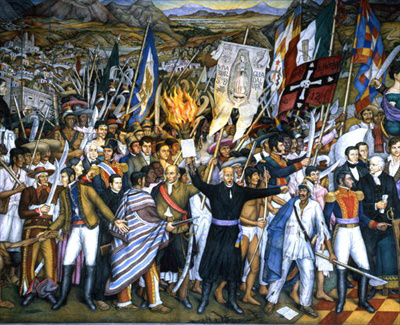 |
Peoples' movements and protests |
 |
|
MobilizationsLatin American wars of independenceNorth American war of independenceSlave uprising in HaitiIrish nationalism and Sinn FéinRussian revolutionIndia independence movementChinese revolutionAlgerian war of independencePalestinian movementVietnam warBreton movementBasque movementNorwegian opposition to EUTo National movementsTo main page |
Latin American independence
The idea of independence began to arise in the South American upper class in connection with the French Revolution<LÄNK>. It had led to the liberation of the slaves in Haiti, and this greatly frightened the South American upper class. But the thing began to move only when Napoleon invaded Spain and deposed its king. In order to prevent ”anarchy” or popular uprisings and to be able to remain in their privileges, the Spanish-born upper class was then forced to set up its own governments in South America. This negative and unimaginative program continued to plague the region for nearly two hundred years. In three places, however, there was another pattern that came to have far-reaching consequences.
One was Brazil. It was ruled from Portugal, but after Napoleon’s invasions, the role was reversed; Brazil became the center of the Portuguese Empire with the Portuguese government intact – a government that became increasingly Brazilian as time went on. Another was the La Plata region. It was Buenos Aires’ middle class that revolutionized and declared independence. Their main purpose was to exploit the countryside, against which the countryside defended itself. Most pervasive in Paraguay, which became the only Latin American country to apply import substitution policy until, for this rudeness, it was crushed by Argentina and Brazil for English money. Less pervasive in Uruguay, which contented itself with creating its own miniature Argentina, independent of Buenos Aires. The third was Mexico. There it was the economically crucial mining town of Querétaro, with its large Native American mining population, that revolted and demanded justice and equality. The appeal was so widespread that this popular independence movement could never be completely crushed. Independent Mexico must be based on a compromise that explicitly recognized the legal equality of the Indians, which was completely unique in Latin America. Pictured above is a Mexican mural by Juan O’Gorman honouring the uprising. Reading
|
